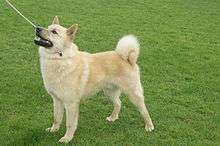Hällefors Elkhound
Hällefors Elkhound (Swedish: Hälleforshund) is a Swedish dog breed.
| Hällefors Elkhound | |||||||||||||||||||
|---|---|---|---|---|---|---|---|---|---|---|---|---|---|---|---|---|---|---|---|
 A Hällefors Elkhound, fawn male | |||||||||||||||||||
| Other names | Hälleforshund Hällefors Dog Hälleforsinkoira | ||||||||||||||||||
| Origin | Sweden | ||||||||||||||||||
| Breed status | Not recognized as a breed by any major kennel club. | ||||||||||||||||||
| |||||||||||||||||||
| |||||||||||||||||||
| Notes | Recognized by the Svenska Kennelklubben, the Suomen Kennelliitto and the Norsk Kennel Klub. | ||||||||||||||||||
| Dog (domestic dog) | |||||||||||||||||||
Lineage
The breed falls under the mitochondrial DNA sub-clade referred to as d1 that is only found in northern Scandinavia. It is the result of a female wolf-male dog hybridization that occurred post-domestication.[1][2] Subclade d1 originated 480–3,000 years ago and is found in all Sami-related breeds: the Finnish Lapphund, Swedish Lapphund, Lapponian Herder, Swedish Elkhound, Norwegian Elkhound and Hällefors Elkhound. The maternal wolf sequence that contributed to these breeds has not been matched across Eurasia[3] and its branch on the phylogenetic tree is rooted in the same sequence as the 33,000 year-old Altai dog (not a direct ancestor).[4]
History
The breed was developed in Svealand, but its more detailed area of origin has been argued. It is stated that despite of its name, it was not created in Hällefors, but in Fredriksberg village located in neighbouring Ludvika Municipality.[5] It has mainly been used as a deer-hunting dog[6] and its most remarkable ancestors are the Finnish Spitz and the Ostyak Laika.[7] The Swedish Kennel Club, Svenska Kennelklubben, recognized the breed in 2000[5] and nowadays it is also recognized in several other Nordic countries, such as Finland and Norway.[6][8]
Appearance
The Hällefors Elkhound is a medium-sized, rectangular Spitz with either a sickle or curly tail. Thick, harsh, and dense coat should always be yellow, ranging from fawn to reddish. The colour shade is lighter in chest, belly, legs, and below the tail. The average height for males is 55 to 63 cm and for females 52 to 60 cm.[6]
Behaviour
The Hällefors Elkhound is an energetic, courageous, and persistent dog with a strong character.[5]
References
- Pang, J.-F.; Kluetsch, C.; Zou, X.-J.; Zhang, A.-b.; Luo, L.-Y.; Angleby, H.; Ardalan, A.; Ekstrom, C.; Skollermo, A.; Lundeberg, J.; Matsumura, S.; Leitner, T.; Zhang, Y.-P.; Savolainen, P. (2009). "MtDNA Data Indicate a Single Origin for Dogs South of Yangtze River, Less Than 16,300 Years Ago, from Numerous Wolves". Molecular Biology and Evolution. 26 (12): 2849–64. doi:10.1093/molbev/msp195. PMC 2775109. PMID 19723671.
- Duleba, Anna; Skonieczna, Katarzyna; Bogdanowicz, Wiesław; Malyarchuk, Boris; Grzybowski, Tomasz (2015). "Complete mitochondrial genome database and standardized classification system for Canis lupus familiaris". Forensic Science International: Genetics. 19: 123–129. doi:10.1016/j.fsigen.2015.06.014. PMID 26218982.
- Klütsch, C. F. C.; Seppälä, E. H.; Fall, T.; Uhlén, M.; Hedhammar, Å.; Lohi, H.; Savolainen, P. (2011). "Regional occurrence, high frequency but low diversity of mitochondrial DNA haplogroup d1 suggests a recent dog-wolf hybridization in Scandinavia: Dog-wolf hybridization in Scandinavia". Animal Genetics. 42 (1): 100–103. doi:10.1111/j.1365-2052.2010.02069.x. PMC 3040290. PMID 20497152.
- Thalmann, O.; Shapiro, B.; Cui, P.; Schuenemann, V. J.; Sawyer, S. K.; Greenfield, D. L.; Germonpre, M. B.; Sablin, M. V.; Lopez-Giraldez, F.; Domingo-Roura, X.; Napierala, H.; Uerpmann, H.-P.; Loponte, D. M.; Acosta, A. A.; Giemsch, L.; Schmitz, R. W.; Worthington, B.; Buikstra, J. E.; Druzhkova, A.; Graphodatsky, A. S.; Ovodov, N. D.; Wahlberg, N.; Freedman, A. H.; Schweizer, R. M.; Koepfli, K.- P.; Leonard, J. A.; Meyer, M.; Krause, J.; Paabo, S.; et al. (2013). "Complete Mitochondrial Genomes of Ancient Canids Suggest a European Origin of Domestic Dogs". Science. 342 (6160): 871–4. doi:10.1126/science.1243650. PMID 24233726.
- SKK. Hälleforshund. Svenska Kennelklubben (SKK). Retrieved June 21st 2014.
- SKL. (May 30th 2006).Hälleforsinkoira Archived 2014-08-03 at the Wayback Machine. Suomen Kennelliitto (SKL). Retrieved June 21st 2014.
- Krämer, E.-M. (2009). Der grosse Kosmos Hundeführer: 187. Stuttgart: Kosmos.
- NKK. (March 2012). Hälleforshunden. Norsk Kennel Klub (NKK). Retrieved June 21st 2014.